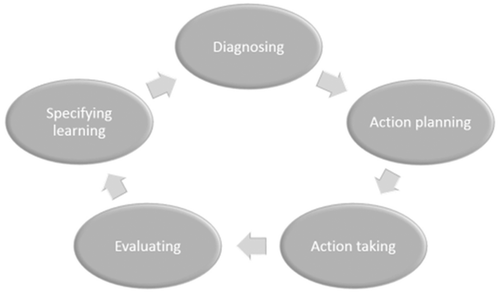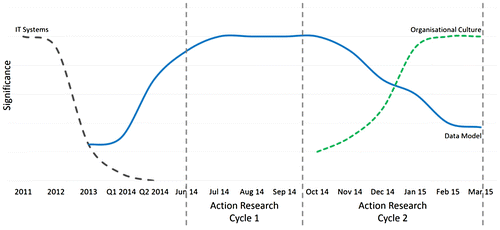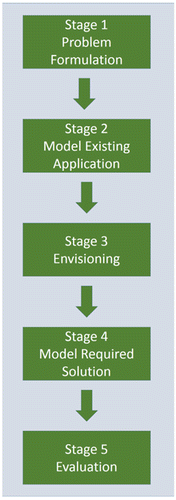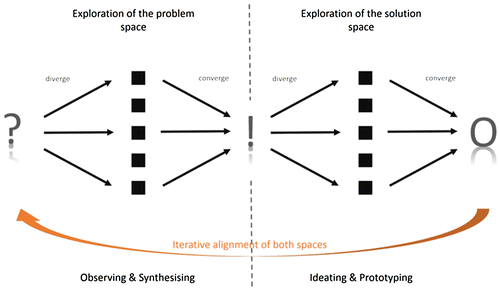Abstract
Requirements analysis is an integral part of the development of Information Systems, and is essential to ensure that the system delivers the expected benefits. However, it is not a straightforward process, and the fact that Information Systems are used by humans introduces the human factors of complexity and unpredictability. This paper puts forward a requirements analysis process which involves the application of agile and design thinking to business oriented data modelling.
What is the data driven initiative being reported?
The Agile Design Data Modelling (ADDAM) process can be used by business users who need to specify requirements for IT implementations. It is a cost effective process which engages business stakeholders, and utilises data modelling in conjunction with design thinking and an agile mind-set to build a common understanding, clearly define the problem(s) to be solved, and explore the solution. The requirements analysis and solution exploration are conducted well in advance of the technical system development.
The ADDAM process as outlined in Figure comprises the following five stages:
Stage 1: problem formulation
This first stage is the identification of the primary problems that are the underlying causes of the organisation’s desire for change
Stage 2: modelling existing
Data modelling is often used at the start of IT projects as a technique for communicating requirements from the business users to the IT developers.
However, while the various representatives from across the user community may have an appreciation of the problem to be solved, it is unlikely that the problem will have the same effect on each of their roles. It is also unlikely to be the case that each of them will have a full understanding of the system, structures, or processes surrounding the problem area. It is even less likely that each of the stakeholders will share a common understanding, so modelling the existing system serves a number of purposes, including:
| • | Introduce business stakeholders to the concept of data modelling. | ||||
| • | Build a common understanding amongst all stakeholders. | ||||
| • | Refine the problem to be solved. | ||||
Stage 3: envisioning
This stage is possibly the most critical stage in the process as it ensures that the efforts of the organisation are focused on resolving clearly defined problems which will deliver business value. It is an opportunity for the stakeholder community to take a step back and consider what it is that they are trying to achieve by utilising design thinking techniques to explore the problem space. Without this step, efforts may be spent on resolving problems on a piecemeal basis without recognising the bigger picture and greater organisational context.
The envisioning stage is likely to result in some refinement or development of the problem as formulated during stage 1. It is also possible that it will be identified that the problem is not one that is worth solving or that the organisation has any interest in solving. Another potential outcome is that the definition or the scope of the problem may have changed significantly such that it warrants iterating back to stage 1. The modelling which took place in stage 2 may now no longer be complete and may need to be developed to include additional business areas or systems, or the inclusion of additional stakeholders may be required.
Stage 4: modelling solution
The stakeholders develop a data model which is representative of the solution system, and which has been informed by the outputs from the envisioning stage. The data model is developed in an iterative fashion utilising an agile mind-set.
Stage 5: evaluation
Due to the iterative nature of ADDAM Requirements Analysis, evaluation is taking place throughout the process. However, it is still necessary to formally evaluate the outcomes. The evaluation needs to involve all the stakeholders and should consider:
| • | If the problem as identified is still relevant and worth solving. | ||||
| • | If the proposed IT system as represented by the developed data model is likely to solve the problem. | ||||
| • | If there are other factors besides the IT system which need to be addressed. | ||||
Why is it an important initiative?
All too often, IT programmes deliver functioning systems which while technically robust just don’t meet the business expectations or deliver significant value to the business. This focus on business requirements is all the more relevant as Gartner predicts that 50% of investment in business analytics will come from business and not IT by 2020 (Duncan, Citation2014).
However, the requirements are not always immediately obvious, as the business objectives are often unclear, the problem context is not comprehensively understood, and end users often lack understanding of the organisational data and systems infrastructure.
Without a clearly defined business problem to be solved, the implementation of new IT systems rarely delivers a substantial impact on the business (Yeoh & Koronios, Citation2010). Technical solutions are often developed to specifically address a business problem without exploring and developing an understanding of the desired business outcomes. This can lead to IT systems being developed to solve problems which aren’t really worth solving, or systems that are perceived as failures because they were unrealistically expected to solve problems which actually require other organisational changes as well as the technical solution.
How was the initiative implemented?
The study was focused on the requirements analysis for a significant IT project in one of the organisations that the author has worked with. The objective of the study initially was to build a data model for the IT implementation. However, by structuring the project within an Action Design Research study, conducting the data modelling in a business oriented rather than IT oriented way, applying design thinking, and an agile mind-set, it delivered much more in terms of business value to the organisation.
The combination of Action Design Research, Design Thinking, and Agile was very appropriate as they are very complimentary, sharing common features such as ‘user-centricity’, ‘iterative learning and development’ and ‘extensive team communication’.
Action Design Research produces highly relevant research results because it is grounded in practical action, aimed at solving an immediate business problem (Baskerville, Citation1999). When it comes to organisational structure, business processes and the associated information systems, the problems are rarely well structured or clearly defined. The fact that organisations are made up of humans, and Information Systems are used by humans introduces the human factors of complexity and unpredictability. These factors can be better understood by conducting research in a real-world practical environment (Kock, Citation2004).
Design Thinking is a human-centred approach which is focused on the users and their needs, so as to ensure that the developed solution meets a real need being experienced by a real user. It treats both the problem and the solution as something to be explored, and involves the diverging exploration of problem and solution space and converging processes of synthesising and selecting (Lindberg, Meinel, & Wagner, Citation2011) as shown in Figure . By deliberately exploring the problem space, design thinking allows a view of the bigger picture to be formed, and it gives organisations the freedom to explore multiple ways to solve problems, and discover the option that best delivers competitive advantage (Clark & Smith, Citation2008).
Agile has been successfully adapted within the software development domain and can help to create a project environment where practitioners are more engaged.
The data model was developed in iterations with the modelling conducted using an agile mind-set, featuring a high degree of collaboration between the user and technical communities. If the business users had simply specified their requirements and a data modeller developed the model in isolation, then additional requirements which were identified, would not have come to light until much later in the project, resulting in increased development cost and delays to the system implementation.
When did this initiative take place?
The problem of information systems requirements analysis is one that the author has had experience of across numerous organisations over the past ten years. The ADDAM Process discussed here was developed as part of an Action Design Research study which involved two cycles, with each cycle progressing through the five phases of Action Design Research as shown in Figure .
Figure 3. The five phases of action design research (after: Susman & Evered, Citation1978).

The first cycle ran from May 2014 to September 2014, with the second cycle running from October 2014 to March 2015. The first ADR cycle involved the user and technical communities collaborating to iteratively develop a data model for the proposed system.
The evaluation of the first cycle revealed a desire for greater innovation in the development of the solution, so the second cycle of this study saw the introduction of design thinking.
Who has benefited from the initiative?
In addition to the better understanding of the business problem and exploration of solutions, the business stakeholders benefitted from this initiative as the ADDAM process ensures that the developed solution is much more closely aligned with their needs. Also, as a data model is a very effective prototyping tool, its use enabled the business stakeholders to get an impression of how the new system would be structured, and they could get an appreciation of what it would be capable of delivering.
In addition to the business stakeholders, the IT stakeholders also benefitted, as the data model is a very effective communications tool between the business and IT groups. As the process delivered a data model for the system to be implemented, it also enables faster and more efficient system development. Furthermore, the likelihood that an IT system will be adopted and used by the business community goes up significantly when both the business and IT have a thorough understanding of the system.
As well as the direct organisational benefits of utilising the ADDAM process, the business stakeholders who were exposed in a very practical way to Design Thinking, Agile, and Data Modelling developed their skills in these disciplines and are now utilising the skills in other aspects of their roles.
Where is the business value being realised from this initiative?
The development of IT solutions is often very focused on the delivery of a solution to a very specific defined problem. The developers are measured on the delivery of a system which works, i.e. it does what it is expected to do, within the budgeted timeframe and budgeted cost. This study has shown how by combining data modelling, design thinking, and an agile mind-set, business users can change how they view not only IT solutions but also how they view their own business and the problems which it is dealing with.
In the case of this study, the fundamental nature of the problem remained fairly consistent throughout, however the important elements to the solution, as illustrated in Figure , changed significantly and the business developed a greater understanding of the real underlying issues.
Figure 4. The relative significance of IT systems, data structures, and organisational culture during the study.

While initially, it was all about an IT solution, particularly hardware and software, and then more about the data structures, it actually transpired that while the data structures are important, the non-technical factors around people and organisational culture are much more significant.
As a result of the success of the requirements analysis process in developing a better understanding of the business and clearly identifying the problem to be solved, the organisation in this case was in a position to develop a much more holistic, effective, and cost efficient solution to a business challenge. While an enhanced IT system, at a cost likely to have exceeded €0.8 M, would have delivered an improvement, it would not have been enough to meet the business expectations.
The data modelling process also brought about a change in how the business approaches data by raising awareness throughout the business of the value and potential of the data and the uses which it can be put in support of business operations.
The ADDAM requirements analysis process can be effective at engaging business stakeholders, building a better understanding of the business and the business problems, and delivering value in terms of both cost savings and what the business can learn about itself and its environment.
Conclusion
The application of the requirements analysis process can go some way towards addressing the challenges of problem understanding and solution finding in IT implementations.
This study, shows how the application of the proposed process prior to the commencement of system development can deliver significant value to an organisation, and recognises the fact that when it comes to Information Systems development, the non-technical factors around people and organisational culture are much more significant than the technological and data-related factors.
Disclosure statement
No potential conflict of interest was reported by the author.
References
- Baskerville, R. L. (1999). Investigating information systems with action research. Communications of the AIS, 2, 4.
- Clark, K., & Smith, R. (2008). Unleashing the power of design thinking. Design Management Review, 19, 8–15.
- Duncan, A. D. (2014). Focus on the ‘Three Vs’ of big data analytics: Variability, veracity and value. Stamford, CT: Gartner Inc.
- Kock, N. (2004). The three threats of action research: a discussion of methodological antidotes in the context of an information systems study. Decision Support Systems, 37, 265–286.
- Lindberg, T., Meinel, C., & Wagner, R. (2011). Design thinking: A fruitful concept for it development?. In Design thinking (pp. 3–18). Berlin Heidelberg: Springer.
- Susman, G. I., & Evered, R. D. (1978). An assessment of the scientific merits of action research. Administrative Science Quarterly, 23, 582–603.10.2307/2392581
- Yeoh, W., & Koronios, A. (2010). Critical success factors for business intelligence systems. Journal of computer information systems, 50, 23–32.


